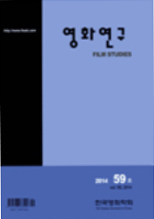- 영문명
- Characteristic and limitation of Joseon's cholera- and smallpox sanitary film from the Viewpoint of the Weimar Republic's sanitary film
- 발행기관
- 한국영화학회
- 저자명
- 김금동
- 간행물 정보
- 『영화연구』제55호, 35~82쪽, 전체 48쪽
- 주제분류
- 예술체육 > 예술일반
- 파일형태
- 발행일자
- 2013.03.31
8,560원
구매일시로부터 72시간 이내에 다운로드 가능합니다.
이 학술논문 정보는 (주)교보문고와 각 발행기관 사이에 저작물 이용 계약이 체결된 것으로, 교보문고를 통해 제공되고 있습니다.

국문 초록
영문 초록
This study roughly examines what conditions inside and outside filmhad been created for the development of sanitary films in Germany, whowere the subjects, and how medical objectivity and academic integritycould be secured in the sanitary films, and based on this, it analyzes theproduction background, unique format of Joseon’s sanitary films producedand screened in 1920 and 1922, and their limitations as sanitary film. Germany that led modern medicine had already secured severalacademic environments in which sanitary films could have medicalobjectivity and academic integrity; that is, the development of modernmedicine, the popularization of sanitary discourses, the foundation ofmedical colleges, medical facilities and research institutes, the constructionof sufficient medical professional staffing, the establishment of productiondivision specialized in cultural films and sanitary films, and medicinespecialists’ active participation in film production. In particular, filmprofessionals and medicine specialists, most of all, regarded medicalknowledge and information, and their objectivity and academic integrityas the most important elements of sanitary films. To enlighten the publictruly and make them practice medical knowledge and information learnedthrough the sanitary films in their daily life, first, the sanitary films, firstof all, could truly persuade them, and they could obtain such a persuasive power only when medical bases were proposed and medical researchresults were shared through the films; second, there should be sufficientmedical facilities and human resources secured through which peoplecould be treated when they actually caught a disease or contagiousdisease and also economically, they could afford the costs, and; third,water and sewage facility, modern housing and the filth processing systemshould be secured so that individuals could make a hygienic living ineveryday life. Germany already had these film external conditions, andthus, German sanitary films, in fact, could considerably succeed inpersuading and making the German people practice them in daily life. And yet, Joseon that had been even deprived of a chance to acceptmodern medicine and film technologies independently, did not have anyhuman resources such as doctors, medical scientists, social hygienists aswell as infrastructures such as hospitals, medical colleges and medicalresearch institutes, which were the prerequisites of hygiene practices. Thisalso tells us that Joseon’s sanitary films could not but start withouthaving the essential features of the sanitary film genre such as providingmedical knowledge and information based on medical grounds. In fact,Joseon’s first sanitary film, cholera sanitary film produced in 1920 wasborn with a crucial limitation that it did not present the most basic andessential medical knowledge and information on cholera; for example, thepreventive means of cholera, the causes of contagion of cholera, the routeof contagion, the symptoms of cholera, actions required in the contagionof cholera, and the therapy method. A simple slogan that people shouldget rid of filthy habits and make efforts to be clean in order to preventcholera in the place where medical knowledge and information should beentered, and this simple slogan left a room for distorted interpretation sothat Joseon’s audience could think as if the main cause of choleracontagion was in their filthy and indolent living habits. Consequently, the film’s purpose or effect also was very likely to be distorted. Moreover,the fact that the production and screening of sanitary films werecontrolled by policy by the Japanese authorities suggests that Joseon’ssanitary film began progressing and developing in the favorable directionof the colonial regime from the beginning, in other words, in the directionof contributing to the Joseon people’s unconscious adaptation andsubordination to the colonial ideology under the title, for the Koreans’health.
목차
1. 들어가며
2. 독일의 위생정책 및 위생영화의 일본과 조선에서의 수용
3. 독일 바이마르공화국의 위생영화
4. 조선 콜레라위생영화와 천연두위생영화의 특징과 한계
4. 나가며
키워드
해당간행물 수록 논문
- 1920년대 초반 조선의 영화산업과 조선영화의 탄생
- <사랑방 손님과 어머니>의 각색과 3막구조 연구
- Early Silent Western Films: the establishment of the genre convention
- 통합예술교육과 STEAM(융합인재교육) 기반의 영화교육 교육과정 개발 필요성 연구
- 영화연기 고유성 측면에서 바라본할리우드 메소드 연기의 반작용
- <피에타>를 통해 본 몸의 사회학적 연구
- 한국영화에서 한국전쟁이 재현되는 변화과정에 관한 연구
- <도가니>(황동혁, 2011)와 <부러진 화살>(정지영, 2012)
- 영화와 기술 그리고 ‘사회적인 것’의 구성
- 한국 예술영화 담론의 흐름에 관한 연구
- 2000년대 한국 스릴러 영화의 모성 재현 연구
- 국제공동제작영화의 지원 정책과 현황 연구
- 변신모티브영화의 시각성
- 시뮬라시옹을 통해 본 <사랑을 카피하다>
- 자기조력적 영화치료와 상호작용적 영화치료의 효과 비교
- 영화연기의 내면성(內面性)에 관한 연구
- 관객으로서의 탈북자: 탈북의 자기표상과 영화 수용
- 영화연구 제55호 목차
- 독일 위생영화를 통해 본 조선 콜레라위생영화(1920)와 천연두위생영화(1922)의 특징과 한계
- 멜로 영화의 내적 리듬과 이미지에 관한 연구
- 이준익 영화의 카니발리즘 연구
- 윤봉춘 일기 연구
- 영화 <마더>에 나타난 수행적 모성 정체성에 관한 연구
- 2012년, 상호텍스트성의 어떤 경향
- 고레에다 히로카즈론
참고문헌
관련논문
예술체육 > 예술일반분야 BEST
- 생성형 AI 도구와 디자이너의 협업 프로세스 개발 - 이미지를 통한 아이디어 확산에서 고해상도 렌더링까지
- 디자인 전공 교과목에서의 생성형 AI 도구 활용 사례 연구
- ‘일과 삶의 균형(Work-Life Balance)’ 척도 개발을 위한 연구
예술체육 > 예술일반분야 NEW
- 한국영화의 촬영과 조명 시리즈 2: 영화 '형사, Duelist'의 Visual Concept 및 조명플랜
- 포스트모더니즘적 영상표현에 관한 연구 -실사 영화와 애니메이션 영화의 상호작용을 중심으로-
- 소니 HVR-Z1N 카메라의 중요한 메뉴에 관한 소고
최근 이용한 논문
교보eBook 첫 방문을 환영 합니다!

신규가입 혜택 지급이 완료 되었습니다.
바로 사용 가능한 교보e캐시 1,000원 (유효기간 7일)
지금 바로 교보eBook의 다양한 콘텐츠를 이용해 보세요!



